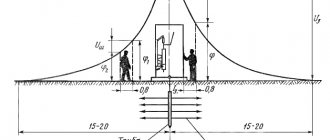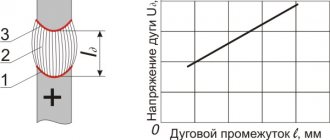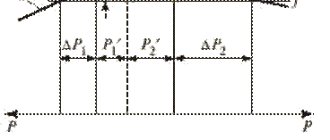Outcome of electric shock
Depending on the situation, the outcome of shock can be varied. If a person receives a strong electric shock, they may experience problems with circulation and breathing. In severe situations, cardiac fibrillation may begin - the heart muscle begins to twitch chaotically. Since the heart essentially stops pumping, blood flow stops. If first aid is not provided in a timely manner, a person may die.
Most often, electric shocks are observed when people are struck by electric current with a strength of up to 1000 V. Burns can occur when exposed to a current of 1 A or higher. This mainly happens if, when working with a current of more than 1000 V, a person does not follow basic safety rules. The current-carrying part is located at a distance quite close to the human body; a spark discharge occurs between them, which leads to severe burns.
If a person accidentally receives a spark discharge, the current at the moment of connection with the body heats the tissue to 60°. This leads to protein coagulation, and a burn forms on the affected area. Electrical burns are difficult to treat.
Consequences of electric shock
And although any dangerous current will be dangerous for a person in most cases, the consequences of its exposure have a number of differences. It depends on the body system that suffered the main damage:
- Nervous. In this case, there may be loss of consciousness or memory, in special cases permanently. If the nerves are affected, then sensitivity or motor activity as such may be impaired. There are also precedents when pathological reflexes appear and physiological ones gradually disappear. In cases of exposure to high voltage, a disorder of the central nervous system occurs and further inhibition of all centers responsible for respiratory and cardiac activity occurs.
- Cardiovascular. Here the basis is functional harm, which is sinus arrhythmia and tachycardia, as well as blockades and extrasystole. Internal bleeding is also possible due to damage to the walls of blood vessels.
- Sense organs. This is mainly tinnitus or decreased sensitivity of the limbs. There may also be ruptured eardrums and deafness. If the eyes are damaged, there is a risk of keratitis, choroiditis and cataracts.
- Long term harm. An electric shock does not always go away without a trace, even after eliminating the damage that occurred immediately. So, a person may subsequently develop neuritis or trophic ulcers. Within the cardiovascular system, disturbances in the conduction of impulses occur. Burns caused by an electric shock heal, but in rare cases they develop deformation of the musculoskeletal system. Subsequent exposure to current can provoke arteriosclerosis or autonomic changes.
The danger is also that it is not always possible to completely cure a person after this. In special cases, it is difficult to even level out the passive pain that a person experiences.
Avoiding harm from electric shock is much easier than it might seem. Using devices that comply with the Eligibility Regulations, and also not touching electrical devices with wet hands - basic safety requirements - will significantly reduce the likelihood of an impact.
Signs of burns from electrical shock
There is such a thing as electric tags. These are dead patches of yellowish skin that look like calluses. If the current penetrates deep into the skin, the body tissue will die over time.
Signs of an electrical burn:
- the skin in the area of impact turned red;
- burns with the formation of blisters began to appear at the site of the outbreak;
- the tissues at the site of impact were charred;
- Pieces of metal could get into the skin when straightening clothes.
The most dangerous thing is if the electric shock hits the area:
- temples;
- backs;
- hands;
- shins;
- back of the head;
- neck.
Additional impacts
Among other things, it is also necessary to take into account other effects that direct and alternating current creates when passing through the human body. These include:
- Electric shock. It provokes stimulation of all tissues, which leads to convulsions and their consequences. These may include loss of consciousness, respiratory or cardiac dysfunction, and death.
- Electrical injury. This is damage that is caused directly to the body. There are two types of them:
- Electrical burn. It is divided into current, which represents the passage of current through the entire body, and also arc, the appearance of which occurs between the conductor and a person. It can be clearly identified by the arc that appears upon contact. And it is also several times more dangerous than current, since its temperature can be several times higher.
- Metallization of leather. A phenomenon that means when metal particles enter the skin. The consequence of this is increased conductivity and greater risk of injury.
It is also worth remembering about electrical marks, which represent the places where the current entered and where it came out from.
Classification of electric current according to the degree of impact on humans
Electric current varies in its degree of impact on humans. He can be:
- tangible;
- unreleased;
- fibrillation.
An electric current is called palpable, and when struck, a person feels obvious irritation. You can feel a current shock at 0.6 mA.
Non-releasing - electric current that causes involuntary convulsive movements of the limbs that touch the exposed wires.
Alternating current, passing through the cells of the human body, delivers impulses that cause a person to experience an adhesion effect.
Fibrillation current when struck causes problems with the cardiac system. At this moment the person may die from cardiac arrest.
Basic norms and rules of electrical safety
The key regulatory documents regulating the field of electrical safety are the following:
- Rules for the construction of electrical installations ( PUE. Edition 7, chapter 1.7 ) –
- Rules for technical operation of consumer electrical installations ( PTEEP ) –
- Rules for labor protection during operation of electrical installations –
- Instructions for the use and testing of protective equipment used in electrical installations -
When performing any work on electrical equipment, the following rules must be observed:
- When designing and installing electrical networks, emergency devices must be used that de-energize the network in the event of a short circuit (short circuit) and in the event of a short circuit to ground. The installation of a ground loop is mandatory.
- Persons with appropriate clearance are allowed to work.
- Special clothing and personal protective equipment required by regulatory requirements must be used.
- It is not allowed to turn on and use equipment and electrical appliances if there is damage to the housing, or to use cables if damage to the insulation is detected.
- It is not allowed to carry out repair work without de-energizing the network.
- Personnel must be able to provide first aid in case of electric shock to a person.
Dangerous current
Depending on the situation, voltages of different magnitudes can pass through the human body, which means that the consequences of the damage can be diverse. You need to know that a current that is dangerous to a person has a current strength of more than 15 mA, at which a person is not able to free himself without outside help. A current of 50 mA can cause severe damage to health, and a current of 100 mA when exposed for 1-2 seconds is considered fatal and usually causes cardiac arrest.
The most dangerous current for humans is alternating current, the frequency of which is more than 50-500 Hz. If its value is about 9 mA, a person is able to free himself from the source of damage (wire). It is necessary to understand that direct current is also dangerous for the life and health of people, and you can get rid of it only if it does not exceed 20-25 mA.
What is the difference between current and voltage?
If we consider a physical process, electrical energy has many different characteristics, among which voltage and current are most often considered. Let us immediately note that these are not the same thing, but they are both interrelated.
Every substance contains an innumerable number of tiny atoms in which electromagnetic interaction occurs between a positively charged nucleus and negatively charged electrons rotating around the nucleus. In the normal state, elementary particles are in balance - the charge of the nucleus is completely compensated by the charges of electrons. But, the influence of an electromagnetic field on atoms causes the most distant electrons to move, and the atoms become unbalanced - they receive a certain charge.
Rice. 1. Atomic structure
Voltage should be understood as the difference between two charges - at one point there is more energy, and at the other less. An analogy can be drawn with communicating vessels: if there is more water in one tube and less in the second, then when they are connected, water from the first will flow into the second. It’s the same with voltage - potentially at each point there is a certain charge of energy created by the electromagnetic field, but until these points are connected by an electrical circuit, the charged particles will not begin directed movement.
Rice. 2. What is voltage
But, with the advent of a connecting chain, the voltage between two points will lead to the directed movement of charged particles. This phenomenon is called electric current.
Depending on the characteristics of the electrical energy source, voltage and current can be:
- constant nature - regardless of the presence or absence of a load, the voltage value does not change, refers to sources of unlimited power;
- vary depending on the load - refers to a source with limited power, where the supply voltage decreases when the circuit is closed;
- temporary - when a load is connected to a power source, the charge is completely dissipated after a short period of time; these are capacitors, in some situations an induced voltage.
Therefore, current cannot flow without the presence of voltage in a section of the circuit, but it is the current that determines the intensity of the impact of electrical energy on a person.
What alternating current is dangerous for humans?
People who regularly work with electronic and electrical devices know what alternating and direct current is. But not all of them have information about which of them is more dangerous for humans.
It is worth understanding that electricity poses a danger to people; this is influenced by many factors. Such as:
- how long the contact lasted;
- the paths along which the current passed through the body;
- how strong the blow was;
- resistance of the human body.
Alternating current is considered dangerous to humans. Causes:
- Direct current will have the same force on the human body if it is 3 times greater than alternating current. This happens because alternating current excites the nerves much more and stimulates the muscles and heart.
- Death due to electric shock usually results from cardiac arrest. The risk of death is most often present when working with alternating current.
- The resistance produced by the human body is higher than direct current, and the higher the frequency, the lower the resistance.
From this it becomes clear that alternating current is much more dangerous to human life than direct current.
Hazards of AC and DC Current
Human resistance
It is known that electric current can be constant or variable, but not every resident understands the difference between them and knows which has a more serious effect on the body. When asked which current is more dangerous, experts answer – alternating.
Passing through the body
This is explained by the fact that a direct electric current must be three times more powerful than an alternating current in order to be deadly to human health. Variable – faster and stronger, which has a greater effect on nerve endings and muscle tissue (primarily the heart). The electrical resistance of people is covered by direct current power (no more than 50 milliamps). In the case of alternating current, the limit drops to 10 milliamps. If the electrical voltage reaches 500 volts, then both types of current cause equal harm. If the indicator rises, constant electric current is more dangerous in such a situation.
The biological effect of electricity directly depends on the intensity with which the body is exposed to it, and this is an important factor due to which fibrillation of the ventricles of the heart occurs. Lethal electric current for humans is prolonged contact with electrical conductors with a force of 0.25-80 mA. This causes spasms of the respiratory muscles and, as a result, acute asphyxia.
Electricity spreads throughout the body only if there is a point of entry and exit for the current. That is, you need to touch two electrodes at the same time. We are talking about bipolar connection or contact with one electrode. If a part of the human body is grounded, then such a connection is called single-pole. There is also a partial switching on, in which a person isolated from the ground touches opposite poles. In this case, it will pass through the switched-on segment of the arm, and this, as a rule, is not a dangerous current. If there is a high voltage, then an electric shock can strike even if there is no direct contact with the conductor: that is, at a distance, through an arcing contact that occurs if you approach it. Air ionization is the reason that a person comes into contact with installations or wires through which electricity passes. The current of electricity is dangerous for humans, especially in damp weather, since the electrical conductivity of the air is increased. In the case of ultra-high voltage, the electric arc reaches a length of 35 cm.
Electric current is dangerous for the human body, so basic safety requirements must be observed. It itself can be constant and variable, each affecting a person in its own way. Safe work with electrical installations - compliance with all rules and use of protective equipment.
What kind of direct current is dangerous for humans?
Both alternating and direct current pose a danger to humans. The only thing is that variable is 35 times more dangerous than constant. It is worth knowing that a direct current of 50 mA is considered safe, while for alternating current this mark is only 10 mA. But the main thing is that the danger of any current depends precisely on its intensity.
Counts:
- at voltages up to 400 V, alternating current is more dangerous;
- if the voltage is 500 V, the effect of the current is the same;
- at voltages above 500 V, direct current is more dangerous.
Alternating current flows intermittently, while direct current flows continuously. When struck by alternating current, there is a chance of breaking away from the source of shock. It is worth understanding that the danger is represented not only by the type of current that struck the person, but also by which area was struck. The most dangerous path of current is through the heart, brain, and lungs.
Direct current is dangerous for humans, as an electric shock can cause burns or breathing problems.
Validity of danger
Previously, we briefly touched on why direct and alternating current are dangerous for humans. It's time to look at all the factors in more detail. There are four factors:
- Current and voltage. Current is measured in milliamps (mA). So, for an alternating voltage, a value from 10 to 15 mA is enough under a “standard” voltage of 120 V, and for a constant voltage of about 50-80 with a voltage of U = 42 V to cause harm to a person. However, you should not think that constant therefore becomes safer, because at the same 500 V both become equal in damage caused.
- Duration. It is obvious to everyone that the longer one is under electric shock, the worse it gets. However, not everyone knows why this is so. Being exposed to current for a long time destroys the epidermis and, as a result, reduces the resistance of the body, which automatically “increases” the current strength.
- Frequency. it represents the value of the fluctuations of the poles of the network, which in the CIS countries reaches 50 Hz. However, this unit of measurement has nothing to do with direct current, since in its case the electrons move in one direction. The Skin Effect already discussed is achieved at a frequency above 20 kHz, and this was experimentally proven by Nikola Tesla.
- Resistance. Understanding how it works doesn't require any special knowledge. It is only worth remembering that an increase in resistance is associated with a lower current strength, and vice versa. If there are dry and rough areas of skin on the body, then they can act as a dielectric, which will set the body resistance value from 40,000 to 100,000 Ohms.
- high body temperature;
- damaged epidermis;
- high ambient humidity.
Sweating also reduces the body's resistance because it introduces moisture and increased temperature.
Now we not only know which values are unsafe for humans, but also why this is so.
What organs are affected by electricity?
How severely a person's body is affected at the moment of electric shock depends on the path along which the current passed. In practice, there are several options by which current can pass through the body:
- If a person picks up a bare live wire with both hands. This path is called hand-to-hand and passes between the hands, affecting the respiratory organs and the heart.
- When a person stands on the ground, he touches the exposed wire with his hand. The path is called arm - legs, the current penetrates through the internal organs of breathing and heart.
- The worker stands with his feet on the ground, in the area of the faulty grounding. The legs receive a shock. The path of the current is called leg-leg.
- When a person accidentally touches a conductive part with his head. The path can be called head - hand, head - feet.
- The most dangerous paths through which current can pass through the body are those that involve the most important systems for a person.
What types of electrical injuries exist, protective equipment and first aid
Show flow chart (Types of electric shock)
Electrical burns, depending on the nature of the impact caused to the victim, can be contact and arc. Electrical burns of the first type occur when the body comes into direct contact with a conductor. The degree of burn depends on the duration of such contact and amperage.
There are different degrees of electrical burns:
- The safest injuries are first degree , which affect only the upper layers of the skin and are expressed in its hyperthermia and slight swelling. Recovery takes place without special therapy.
- Second degree skin lesions extend deep into the germ layer . In the area affected by the electric current, blisters filled with a clear liquid form, which should not be punctured. The damaged area may be quite painful. If the affected area is small, the burn goes away without special treatment.
- The third degree is characterized by the death of cells in the inner skin layers , the formation of blisters filled with bloody fluid. Severe redness of the skin is observed in the affected area. In the worst case, it darkens, which indicates tissue necrosis. In this condition, the skin does not regenerate, so the victim requires specialized medical care.
- The most extensive injuries of the fourth degree are associated with burnout of the skin, muscles, and thermal damage to bones. This condition can pose a serious threat to life, so specialized medical care is mandatory.
Electrical marks are specific spots with clear boundaries on the surface of the skin in the area exposed to electric shock. They have a gray or pale yellow tint. The size of such spots is 1-5 mm; there is usually a depression in the center. The shape of the sign can follow the shape of the conductive part, contact with which caused its appearance. The skin in the area of the electric sign hardens. There is no pain or inflammation.
Metallization of the skin is the penetration of molten microscopic particles of conductor metal into its layers. Typically observed when a switch is turned off under load or when attempting to disconnect shorted wires.
Only exposed skin areas are affected, so the main means of preventing metallization is the use of special clothing and protective equipment when working with electrical equipment. During metallization, victims note a sensation of a foreign body and pain at the site of injury. As a rule, metallic skin gradually peels off, and injuries heal without scarring. In the first minutes, it is recommended that the victim apply a sterile bandage.
Electroophthalmia is inflammation of the eyes as a result of ultraviolet radiation from an electric arc. It occurs within 4-8 hours after irradiation of the eyes and is manifested by redness, inflammation, profuse lacrimation, and headache. In severe form, it can lead to loss of vision, so if symptoms develop, you should immediately consult a doctor.
To prevent electrophthalmia, it is necessary to wear safety glasses when working
The listed electrical injuries are local. There are also general electrical injuries , which are characterized by the negative impact of electricity on the entire body. Victims often lose consciousness and develop breathing and heart problems.
The most dangerous phenomenon is ventricular fibrillation, which often ends in death. If the victim of an electric shock is unconscious, he is immediately given cardiopulmonary resuscitation.
With electrical injuries, imaginary death often develops, in which the signs of the body’s vital functions become almost invisible, but the person can be saved. Therefore, cardiopulmonary resuscitation is carried out until the last minute.
First aid to victims of electric current is provided in the following order:
- The victim is released from the effects of electricity . In this case, the person providing assistance must take measures to ensure their own safety.
- Determine the condition of the victim - checking breathing, pulse, etc.
- They free a person from excess clothing, which makes breathing difficult.
- Examine the oral cavity and, if necessary, clean it of vomit, clots of mucus and blood.
- Cardiopulmonary resuscitation measures are initiated.
Show flowchart (Electrical injury at work)
During the provision of assistance, a sufficient supply of fresh air must be ensured in the room and unnecessary people must be removed. Persons who are not directly involved in providing first aid must call doctors and report the incident to the head of the organization (in case of a work-related injury).
You also need to examine the victim for electrical burns and apply a clean, dry bandage to them. After this you need to wait for the doctor. All cases of electrical injuries are subject to hospitalization , even in the absence or removal of dangerous symptoms. This is due to the possibility of developing fibrillation or delayed arrhythmia several hours after the lesion.
Show Flow Diagram (Factors Affecting the Outcome of Electrical Shock)
For a more detailed study of the topic of providing first aid to victims of electric current, we recommend that you familiarize yourself with the methodological material -
Paths of current passing through the human body
What kind of current is dangerous for a person depends not only on its magnitude, but also on the path through the body.
When a person comes under voltage, the current tends to travel the shortest distance. Depending on the place of contact, various organs and parts of the body can enter the affected area. There are different options for the passage of electrical current through the body. Some of them are less common, others more common.
Particularly dangerous are those current paths that damage the heart, spinal cord, brain and lungs. True, this does not mean that other paths are safe.
Information! Electrical injury statistics include only those cases in which the victim required medical assistance.
Hand - hand
Most often, electricians are injured during work when they touch a phase conductor and a grounded structure or another phase conductor with different hands.
Such injuries account for about 40% of all visits to doctors. The current passes through the upper chest and up to 3.3% passes through the heart. When injured by a voltage of 220 V, up to 83% of victims lose consciousness.
Right hand - legs
The passage of electric current along the arm-to-leg path is life-threatening. Electricity passes through the heart, legs and spinal cord, with the heart muscle accounting for 6.7%.
This type of electrical injury occurs if a worker is wearing shoes with nails in the soles and the floor is concrete or damp wood.
The incidence of these injuries is 20%, the rate of loss of consciousness is 87%.
Left hand - legs
The causes of injury in this case are similar to the “right arm - legs” situation, but occurs somewhat less frequently - in 17% of cases. This is due to the fact that most people prefer to work with their right hand.
The proportion of current passing through the heart is 3.7%, so the number of victims who lost consciousness is 80%.
Leg - leg
This passage of current occurs when a person comes under step voltage. These cases are only 6%. The proportion of current through the heart is 0.4%.
The main danger of such injuries is cramps or spasms of the legs. In this case, a person may fall and the magnitude of the step voltage will increase, and the current will follow the “arms-legs” or “head-legs” path, so victims lose consciousness in 15% of cases.
Head - legs
Quite rare, about 5% of cases, but a dangerous situation. Occurs when working without headgear in switchgear and high control panels.
The brain and spinal cord, spine and internal organs are affected. The portion of the current passing through the heart is 6.8%. Up to 88% of victims lose consciousness and require resuscitation and hospitalization.
Head - hands
This situation is more dangerous than a head-leg injury. Part of the current passing through the heart is 7%; those caught under voltage lose consciousness in 92% of cases.
The causes of injury are similar to the previous one, the frequency of occurrence is 4%.
Other ways
About 8% of cases of electrical injuries are associated with touching live parts with other parts of the body. Most often this happens when working without overalls or in the summer, in unbuttoned jackets without a shirt.
Important! To prevent electrical injuries, it is necessary to comply with the requirements of safety regulations and use basic and additional protective equipment - gloves, galoshes, mats and tools with insulated handles
Types of Electrical Injuries
In general, injuries caused by electric shock are called local, mixed and general (“electric shock”).
- Local injuries are localized lesions, violations of the integrity of the skin, ligaments and bones. One of the most common signs of local electrical injuries (more than 60% of the total number of industrial injuries) is a burn.
Burn after electric shock
Electrical burns come in two types:
- current (contact) - occurs when a person touches a live part of an electrical installation (bare socket wires, broken extension cord, etc.);
- arc - occurs when interacting with an electric arc that has a very high combustion temperature (there are cases when the arc can go beyond the “untouch zone” and touch a person). In this case, an extremely strong thermal effect on a person occurs;
- electrical signs on the body (marks) - are obtained as a result of superficial disorders of human skin and are clearly visible pigments on the skin of gray or gray-yellow color. The burn on the body is externally similar to the shape of the live part that was touched;
Electric sign on the body after an electric shock
- metallization of the skin is the result of molten metal particles coming into contact with the skin during the passage of an electric arc through it. The surface of the victim’s skin becomes rough, and the color is determined by the color of the metal from which the conductor is made: green - when interacting with copper, gray - with aluminum, bluish-green - with brass, gray-yellow - with lead;
- electroophthalmia is a medical term that describes inflammation of the outer membrane of the eye during exposure to ultraviolet radiation when an electric arc occurs (for example, during electric welding).
Consequences of electroophthalmia
- General (electric shock) is a condition of the human body in which spontaneous convulsive contractions of some muscles of the body occur after an electric shock.
- Electric shocks are divided into four main degrees:
- muscle contraction, while the person remains conscious;
- muscle contraction, while the victim loses consciousness, but retains the basic vital functions of the body;
- loss of consciousness and disruption of the heart and lungs (due to the coincidence of the frequency of contraction of the vital organs of the body with the frequency of the electric current);
- clinical death is a term meaning a state of the victim that is as close as possible to biological death, which occurs shortly after the heart stops working.
Loss of consciousness after electric shock
- Mixed electrical injuries are a combination of local and general injuries to varying degrees.










